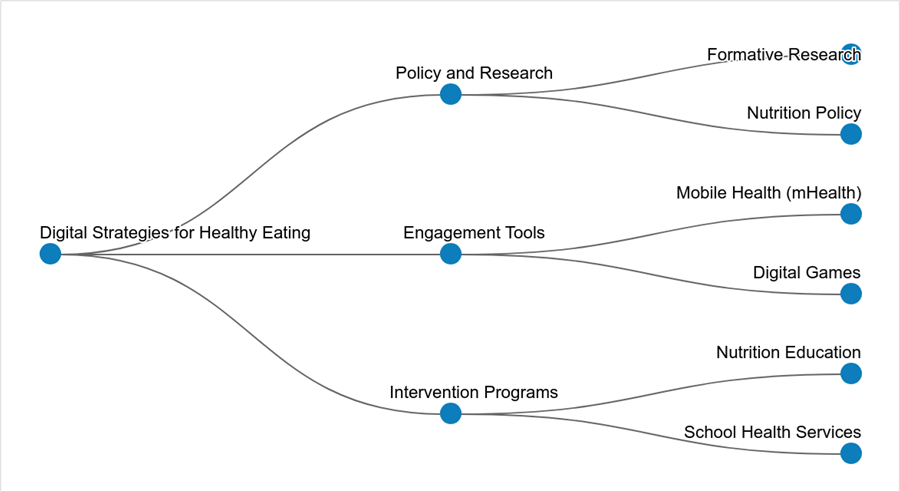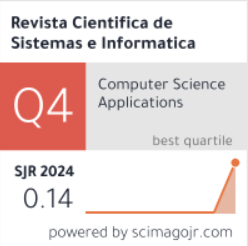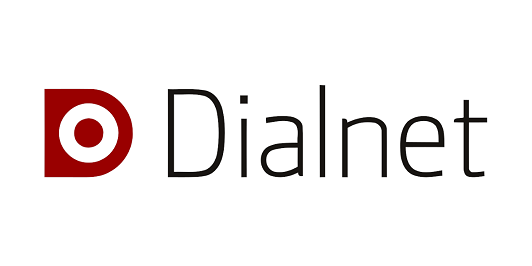Digital strategies for healthy eating in schoolchildren beneficiaries of state programs
DOI:
https://doi.org/10.51252/rcsi.v5i2.958Keywords:
digital access, eating habits, mobile apps, nutritional literacy, school programsAbstract
This study addresses the application of digital strategies to promote healthy eating among schoolchildren benefiting from state programs, given their relevance to child health and their transformative potential. An exploratory systematic review was conducted, focusing on scientific articles published between 2020 and 2024 in the Scopus database. Twenty-eight selected studies were analyzed using inclusion criteria related to methodological quality, thematic relevance, and open access. The results identify a variety of technologies, such as mobile applications, gamified platforms, chatbots, and artificial intelligence-based systems, highlighting those that offer personalization, accessibility, and motivation as the most effective for improving eating habits. However, their implementation faces structural barriers, such as lack of connectivity, low digital literacy, and limited integration with school programs. It is concluded that digital strategies have great potential to transform food education, but their effectiveness will depend on their cultural contextualization, sustainability, and integration with comprehensive public policies that guarantee equity, community participation, and continued implementation.
Downloads
References
Alawamleh, T., & AlKasasbeh, W. (2024). Exploring the Landscape of eHealth in Promoting Physical Activity and Healthy Dietary Intake. Universal Journal of Public Health, 12(1), 120-127. https://doi.org/10.13189/ujph.2024.120113
Allcott-Watson, H., Chater, A., Troop, N., & Howlett, N. (2024). A systematic review of interventions targeting physical activity and/or healthy eating behaviours in adolescents: practice and training. Health Psychology Review, 18(1), 117-140. https://doi.org/10.1080/17437199.2023.2173631
Ardesch, F. H., Van Der Vegt, D. D., & Kiefte-De Jong, J. C. (2023). Problematic Social Media Use and Lifestyle Behaviors in Adolescents: Cross-Sectional Questionnaire Study. JMIR Pediatrics and Parenting, 6(1). https://doi.org/10.2196/46966
Berger, M., & Jung, C. (2024). Gamification preferences in nutrition apps: Toward healthier diets and food choices. Digital Health, 10. https://doi.org/10.1177/20552076241260482
Bjerregaard, A. A., Zoughbie, D. E., Hansen, J. V, Granström, C., Strøm, M., Halldórsson, P. I., Meder, I. K., Willett, W. C., Ding, E. L., & Olsen, S. F. (2024). An SMS chatbot digital educational program to increase healthy eating behaviors in adolescence: A multifactorial randomized controlled trial among 7,890 participants in the Danish National Birth Cohort. PLoS Medicine, 21(6 June). https://doi.org/10.1371/journal.pmed.1004383
Burkhart, S., Hayman, A., Lam, F., Jones, B., Horsey, B., Craven, D., & Underhill, S. (2023). School food programmes in the Pacific Islands: Exploring opportunities and challenges for creating healthier school food environments. Public Health Nutrition, 26(2), 455-466. https://doi.org/10.1017/S1368980022001951
Céspedes Aldana, K., Lovón Cueva, M. A., & Pflücker Romero, C. (2021). El programa alimentario Qali Warma en el Perú: Análisis político desde la visión estatal de Max Weber, Michael Mann y Guillermo O’Donnell [Universidad Nacional Mayor de San Marcos]. https://doi.org/10.31381/pluriversidad.vi09.5434
Cuesta-Vargas, A. I., Biró, A., Escriche-Escuder, A., Trinidad-Fernández, M., García-Conejo, C., Roldán Jiménez, C. R., Tang, W., Salvatore, A., Nikolova, B., Muro-Culebras, A., Martín-Martín, J., González-Sánchez, M., Ruiz-Muñoz, M., & Mayoral, F. (2023). Effectiveness of a gamified digital intervention based on lifestyle modification (iGAME) in secondary prevention: a protocol for a randomised controlled trial. BMJ Open, 13(6). https://doi.org/10.1136/bmjopen-2022-066669
Domínguez-Jiménez, I., Ibarra-Ramírez, A. A., Monzalvo-López, J. M., Serrano-Trejo, M. D., & Suárez Cansino, J. (2024). Estrategia Didáctica Digital en Apoyo a la Educación Nutricional. Ciencia Latina Revista Científica Multidisciplinar, 7(6), 4374-4389. https://doi.org/10.37811/cl_rcm.v7i6.8998
Fagerström, M., Löf, M., Müssener, U., & Thomas, K. (2023). The importance of trusting conditions for organizations’ readiness to implement mHealth to support healthy lifestyle behaviors: An interview study within Swedish child and school healthcare. Digital Health, 9. https://doi.org/10.1177/20552076231181476
FAO. (2024). Nutrición. Organización de las Naciones Unidas para la Alimentación y la Agricultura. https://www.fao.org/nutrition/es/
Fernández-Panaifo, C., & Angulo-Ríos, L. A. (2023). El uso de las TIC y el rendimiento escolar en estudiantes de nivel primaria. Revista Amazonía Digital, 2(2), e282. https://doi.org/10.55873/rad.v2i2.282
Fernández-Sánchez, H., King, K., & Enríquez-Hernández, C. B. (2020). Revisiones Sistemáticas Exploratorias como metodología para la síntesis del conocimiento científico. Enfermería Universitaria, 17(1). https://doi.org/10.22201/eneo.23958421e.2020.1.697
Froome, H. M., Townson, C., Rhodes, S., Franco-Arellano, B., Lesage, A., Savaglio, R., Brown, J. M., Hughes, J., Kapralos, B., & Arcand, J. (2020). The effectiveness of the foodbot factory mobile serious game on increasing nutrition knowledge in children. Nutrients, 12(11), 1-14. https://doi.org/10.3390/nu12113413
Gazibara, T., Cakic, M., Cakic, J., Grgurevic, A., & Pekmezovic, T. (2024). Sociodemographic Characteristics and Digital Behaviors Associated with the Use of Fitness and Diet Apps Among Adolescents. Journal of Research in Health Sciences, 24(3). https://doi.org/10.34172/jrhs.2024.154
Halse, R. E., Shoneye, C. L., Pollard, C. M., Jancey, J., Scott, J. A., Pratt, I. S., Dhaliwal, S. S., Norman, R., Straker, L. M., Boushey, C. J., Delp, E. J., Zhu, F., Harray, A. J., Szybiak, M. A., Finch, A., McVeigh, J. A., Mullan, B., Collins, C. E., Mukhtar, S. A., … Kerr, D. A. (2020). Improving nutrition and activity behaviors using digital technology and tailored feedback: Protocol for the Livelighter Tailored Diet and Activity (TODAY) randomized controlled trial. JMIR Research Protocols, 8(2). https://doi.org/10.2196/12782
Hayek, J., Elliott, K., Vermette, M., & Lafave, L. M. Z. (2023). eHealth Tools Supporting Early Childhood Education and Care Centers to Assess and Enhance Nutrition and Physical Activity Environments: Protocol for a Scoping Review. JMIR Research Protocols, 12(1). https://doi.org/10.2196/52252
Hedin, L., Seiterö, A., Crawford, J., Bendtsen, M., & Löf, M. (2024). Mediated effects of LIFE4YOUth—a mobile health intervention for multiple lifestyle behavior change among high school students in Sweden: findings from a randomized controlled trial. BMC Public Health, 25(1). https://doi.org/10.1186/s12889-025-22097-5
Herrera Cotrina, Á., Manuel, & Salazar del Aguila, C. M. (2020). Aplicación móvil que permita desarrollar conocimientos y hábitos saludables en la alimentación en niños y adolescentes basados en gamificación y juegos serios [Universidad Peruana de Ciencias Aplicadas]. http://hdl.handle.net/10757/653951
Jones Bell, M., Zeiler, M., Herrero, R., Kuso, S., Nitsch, M., Etchemendy, E., Fonseca-Baeza, S., Oliver, E., Adamcik, T., Karwautz, A., Wagner, G., Baños, R., Botella, C., Görlich, D., Jacobi, C., & Waldherr, K. (2020). Healthy Teens @ School: Evaluating and disseminating transdiagnostic preventive interventions for eating disorders and obesity for adolescents in school settings. Internet Interventions, 16, 65-75. https://doi.org/10.1016/j.invent.2018.02.007
Joseph-Shehu, E. M., Ncama, B. P., Mooi, N., & Mashamba-Thompson, T. P. (2020). The use of information and communication technologies to promote healthy lifestyle behaviour: A systematic scoping review. BMJ Open, 9(10). https://doi.org/10.1136/bmjopen-2019-029872
Lian, H., Øverby, N. C., Vik, F. N., Medin, A. C., Osorio, N. G., Helle, C., Bjørkkjær, T., Love, P., Rutter, H., Barker, M. E., Hillesund, E. R., & Helland, S. H. (2024). Implementation strategies: lessons learned during an e-learning intervention to improve dietary behaviors and feeding practices in early childhood education and care. BMC Nutrition, 11(1). https://doi.org/10.1186/s40795-024-00990-3
Ma, Z., Xin, C., & Zheng, H. (2021). Construction of a Teaching System Based on Big Data and Artificial Intelligence to Promote the Physical Health of Primary School Students. Mathematical Problems in Engineering, 2021. https://doi.org/10.1155/2021/9777862
Mayoral, R. M., Helmi, A., Logan, S. W., & Fitter, N. T. (2024). GoBot Go! Using a Custom Assistive Robot to Promote Physical Activity in Children. IEEE Journal of Translational Engineering in Health and Medicine, 12, 613-621. https://doi.org/10.1109/JTEHM.2024.3446511
Merino-Godoy, M. Á., Yot-Domínguez, C., Villaciervos-Moreno, P., & Moreno-Sánchez, E. (2022). Mobile Applications and Healthy Habits of Adolescents, a Strange Couple: Pilot Study of the Efficacy of the Healthy Jeart App. Sustainability (Switzerland), 14(9). https://doi.org/10.3390/su14095249
MIDIS. (2021). Necesidades y posibles soluciones de innovación en el programa nacional de alimentación escolar QALI WARMA (1.a ed.). Ministerio de Desarrollo e Inclusión Social.
Moreno-Guerrero, A.-J., Parra-González, M.-E., López-Belmonte, J., & Segura Robles, A. (2021). Innovating in Nutrition Education: Application of Gamification and Digital Resources in High School Students (Innovando en educación nutricional: Aplicación de la gamificación y recursos digitales en estudiantes de secundaria). Retos, 43, 438-446. https://doi.org/10.47197/retos.v43i0.87569
OMS. (2018). Alimentación sana. Organización Mundial de la Salud. https://www.who.int/es/news-room/fact-sheets/detail/healthy-diet
OPS. (2021). Nutrición. Organización Panamericana de la Salud. https://www.paho.org/es/temas/nutricion
Page, M. J., McKenzie, J. E., Bossuyt, P. M., Boutron, I., Hoffmann, T. C., Mulrow, C. D., Shamseer, L., Tetzlaff, J. M., Akl, E. A., Brennan, S. E., Chou, R., Glanville, J., Grimshaw, J. M., Hróbjartsson, A., Lalu, M. M., Li, T., Loder, E. W., Mayo-Wilson, E., McDonald, S., … Alonso-Fernández, S. (2021). Declaración PRISMA 2020: una guía actualizada para la publicación de revisiones sistemáticas. Revista Española de Cardiología, 74(9), 790-799. https://doi.org/10.1016/j.recesp.2021.06.016
Rahayu, N. I., Suherman, A., & Muktiarni, M. (2023). The Use of Information Technology and Lifestyle: An Evaluation of Digital Technology Intervention for Improving Physical Activity and Eating Behavior. Journal of Advanced Research in Applied Sciences and Engineering Technology, 32(1), 303-314. https://doi.org/10.37934/ARASET.32.1.303314
Ramezankhani, A., Sadeghi, S., Ghaffari, M., & Namdari, M. (2024). Physical Activity Promotion in Schools Using Theoretically Designed Mobile Phone Application. International Journal of Preventive Medicine, 15. https://doi.org/10.4103/ijpvm.ijpvm_106_23
Rodríguez Degiovanni, H. A. (2024). Brecha digital y desigualdad en la educación. En Educación. https://universidadloyola.edu.mx/brecha-digital-y-desigualdad-en-la-educacion/
Shatwan, I. M., Alhefani, R. S., Bukhari, M. F., Hanbazazah, D. A., Srour, J. K., Surendran, S., Aljefree, N. M., & Almoraie, N. M. (2023). Effects of a Smartphone App on Fruit and Vegetable Consumption Among Saudi Adolescents: Randomized Controlled Trial. JMIR Pediatrics and Parenting, 6. https://doi.org/10.2196/43160
Sousa Basto, P., & Ferreira, P. (2024). Mobile applications, physical activity, and health promotion. BMC Health Services Research, 25(1). https://doi.org/10.1186/s12913-025-12489-z
Sunkel, G., Trucco, D., & Espejo, A. (2013). La integración de las tecnologías digitales en las escuelas de América Latina y el Caribe (1.a ed.). CEPAL.
Truman, E., & Elliott, C. (2022). Testing a Mobile App for Participatory Research to Identify Teen-Targeted Food Marketing: Mixed Methods Study. JMIR Formative Research, 6(5). https://doi.org/10.2196/35886
Tugault-Lafleur, C. N., De-Jongh González, O., Macdonald, J., Bradbury, J., Warshawski, T., Ball, G. D. C., Morrison, K., Ho, J., Hamilton, J., Buchholz, A., & Mâsse, L. (2023). Efficacy of the Aim2Be Intervention in Changing Lifestyle Behaviors among Adolescents with Overweight and Obesity: Randomized Controlled Trial. Journal of Medical Internet Research, 25. https://doi.org/10.2196/38545
Valles, M., Injante, R., Hernández, E., Riascos, J., Galvez, M., & Velasco, J. (2020). An Altmetric Alternative for Measuring the Impact of University Institutional Repositories’ Grey Literature. In Lecture Notes of the Institute for Computer Sciences, Social Informatics and Telecommunications Engineering (pp. 222–234). https://doi.org/10.1007/978-3-030-50072-6_17
Vandeputte, J., Herold, P., Kuslii, M., Viappiani, P., Muller, L., Martin, C., Davidenko, O., Delaere, F., Manfredotti, C., Cornuéjols, A., & Darcel, N. (2023). Principles and Validations of an Artificial Intelligence-Based Recommender System Suggesting Acceptable Food Changes. Journal of Nutrition, 153(2), 598-604. https://doi.org/10.1016/j.tjnut.2022.12.022
Yang, Z., Khatibi, E., Nagesh, N., Abbasian, M., Azimi, I., Jain, R., & Rahmani, A. M. (2024). ChatDiet: Empowering personalized nutrition-oriented food recommender chatbots through an LLM-augmented framework. Smart Health, 32. https://doi.org/10.1016/j.smhl.2024.100465
Zhu, D., Dordevic, A. L., Gibson, S., & Davidson, Z. E. (2024). The effectiveness of a 10-week family-focused e-Health healthy lifestyle program for school-aged children with overweight or obesity: a randomised control trial. BMC Public Health, 25(1). https://doi.org/10.1186/s12889-024-21120-5

Downloads
Published
How to Cite
Issue
Section
License
Copyright (c) 2025 Erika del Milagro Lozano-Flores

This work is licensed under a Creative Commons Attribution 4.0 International License.
The authors retain their rights:
a. The authors retain their trademark and patent rights, as well as any process or procedure described in the article.
b. The authors retain the right to share, copy, distribute, execute and publicly communicate the article published in the Revista Científica de Sistemas e Informática (RCSI) (for example, place it in an institutional repository or publish it in a book), with an acknowledgment of its initial publication in the RCSI.
c. Authors retain the right to make a subsequent publication of their work, to use the article or any part of it (for example: a compilation of their works, notes for conferences, thesis, or for a book), provided that they indicate the source of publication (authors of the work, journal, volume, number and date).









